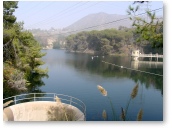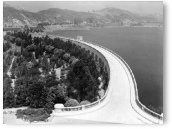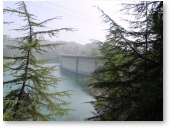Lake Hollywood, a man-made reservoir contained by the Mulholland Dam, is located in the Hollywood Hills and is the most
secluded body of water in the Los Angeles area. Under the direction of the Metropolitan Water District, construction of the
reservoir began in August 1923.
 The dam was designed and constructed by engineer William Mulholland, and the lake, which is part of the Owens River Aqueduct
System, was first filled in 1925. Mulholland also designed the St. Francis Dam and the system of aqueducts that carry water
from Owens Valley to Los Angeles, which provides the city with most of its drinking water. Located in Weid Canyon, east of
Chahuenga Pass, Mulholland Dam is 210 feet high, 933 feet long, 16 feet wide at the crest, and has a maximum depth of 183
feet. 172,000 cubic yards of concrete were used in its construction.
The dam was designed and constructed by engineer William Mulholland, and the lake, which is part of the Owens River Aqueduct
System, was first filled in 1925. Mulholland also designed the St. Francis Dam and the system of aqueducts that carry water
from Owens Valley to Los Angeles, which provides the city with most of its drinking water. Located in Weid Canyon, east of
Chahuenga Pass, Mulholland Dam is 210 feet high, 933 feet long, 16 feet wide at the crest, and has a maximum depth of 183
feet. 172,000 cubic yards of concrete were used in its construction.
The St. Francis Dam disaster of 1928 convinced the City of Los Angeles to reinforce the Mulholland Dam with tons of earth on
the downstream side and to lower the level
 of the reservoir as a precaution against the possibility of a similar catastrophe. In California history, the failure of the
St. Francis dam is second only to the 1906 San Francisco earthquake in terms of loss of life. Around midnight on March 12,
1928, approximately 12.5 billion gallons of water poured down the narrow San Francisquito Canyon, creating
of the reservoir as a precaution against the possibility of a similar catastrophe. In California history, the failure of the
St. Francis dam is second only to the 1906 San Francisco earthquake in terms of loss of life. Around midnight on March 12,
1928, approximately 12.5 billion gallons of water poured down the narrow San Francisquito Canyon, creating
 a 140-foot-high wall of water that swept away nearly 500 men, women, and children. As the dam's engineer and designer,
William Mulholland was personally and professionally devastated, and died a broken man. Ironically, in 1992, a group of
geologists headed by J. David Rogers discovered that the cause of the disaster was not in the design of the dam, but rather
in the geology of the rock foundation. Sophisticated equipment identified that the east abutment had been anchored into a
Paleolithic landslide that could not have been detected at the time of the original construction. As a credit to its engineer,
the Mulholland Dam has withstood the test of time.
a 140-foot-high wall of water that swept away nearly 500 men, women, and children. As the dam's engineer and designer,
William Mulholland was personally and professionally devastated, and died a broken man. Ironically, in 1992, a group of
geologists headed by J. David Rogers discovered that the cause of the disaster was not in the design of the dam, but rather
in the geology of the rock foundation. Sophisticated equipment identified that the east abutment had been anchored into a
Paleolithic landslide that could not have been detected at the time of the original construction. As a credit to its engineer,
the Mulholland Dam has withstood the test of time.
To provide additional reservoir capacity, a small dam was subsequently built in the northern end of the lake. In 1974, the
California State Department of Health Services issued a directive to further improve both water quality and the protection
of open water reservoirs. In addition to the normal environmental hazards that threaten open bodies of water, the Upper and
Lower Hollywood reservoirs also faced potential contamination by surface runoff from the surrounding communities. One proposal
for protecting these waters was to install reservoir covers. In protest of this plan, fifteen community groups formed the
Coalition to Preserve Open Reservoirs (CPOR). As a result of the opposition effort, a mediation process took place which
led to the current solution of buried water storage and a small filtration plant at the base of the dam.
Soon the City of Los Angeles' Department of Water and Power (DWP) moved toward completion of new underground water storage
tanks adjacent to the Upper and Lower Hollywood Reservoirs.
 To make room for these tanks, more than one million cubic yards of soil had to be excavated. Much of the dirt was placed
in fill sites in four canyons near the tanks, and the landform was graded to blend with contours of the existing hillsides.
Once the earth moving and grading was completed, fill sites were planted and irrigated. Ground irrigation continued for
three or four years, after which the established vegetation was maintained by rainwater alone. Today, the surrounding
hillsides are covered by chaparral and coastal sage scrub plant, while fully grown oaks, eucalyptus, pine and wild walnut
trees shade much of the path around the lake. Two of the world's largest underground tanks now store treated water, with
new pipelines linking the tanks to the distribution system. Because these Toyon tanks provide the drinking water previously
supplied directly from the Hollywood Reservoirs, the need to chlorinate the reservoirs has been eliminated. The reservoirs
are kept full in case of emergency, and the DWP is able to environmentally manage them to help maintain the natural
ecosystem.
To make room for these tanks, more than one million cubic yards of soil had to be excavated. Much of the dirt was placed
in fill sites in four canyons near the tanks, and the landform was graded to blend with contours of the existing hillsides.
Once the earth moving and grading was completed, fill sites were planted and irrigated. Ground irrigation continued for
three or four years, after which the established vegetation was maintained by rainwater alone. Today, the surrounding
hillsides are covered by chaparral and coastal sage scrub plant, while fully grown oaks, eucalyptus, pine and wild walnut
trees shade much of the path around the lake. Two of the world's largest underground tanks now store treated water, with
new pipelines linking the tanks to the distribution system. Because these Toyon tanks provide the drinking water previously
supplied directly from the Hollywood Reservoirs, the need to chlorinate the reservoirs has been eliminated. The reservoirs
are kept full in case of emergency, and the DWP is able to environmentally manage them to help maintain the natural
ecosystem.
The reservoir's proximity to Hollywood has made it a convenient location for film shoots. Most notably, Lake Hollywood can
be seen in Roman Polanski's Chinatown (1974) starring Jack Nicholson and Faye Dunaway,
 and in Universal's disaster epic Earthquake (1974) starring Charlton Heston and a long cast of others. To get to
Lake Hollywood from Los Angeles, take 101 Freeway north, exit at Barnham Boulevard and turn right. Turn right onto Lake
Hollywood Drive and follow the signs to the reservoir. Because it is a reservoir for drinking water, the lake is not open
for swimming or boating and dogs are not allowed on the perimeter path. On clear days, joggers and hikers can enjoy the
natural scenic beauty that surrounds the reservoir, including visibility of the Hollywood Sign on Mount Lee and the sculpted
skyline of Tinsel Town. Lake Hollywood is home to an abundance of wildlife including deer, coyotes, rabbits, squirrels,
turtles, hawks, ducks, California quails, woodpeckers, hummingbirds and numerous blue jays.
and in Universal's disaster epic Earthquake (1974) starring Charlton Heston and a long cast of others. To get to
Lake Hollywood from Los Angeles, take 101 Freeway north, exit at Barnham Boulevard and turn right. Turn right onto Lake
Hollywood Drive and follow the signs to the reservoir. Because it is a reservoir for drinking water, the lake is not open
for swimming or boating and dogs are not allowed on the perimeter path. On clear days, joggers and hikers can enjoy the
natural scenic beauty that surrounds the reservoir, including visibility of the Hollywood Sign on Mount Lee and the sculpted
skyline of Tinsel Town. Lake Hollywood is home to an abundance of wildlife including deer, coyotes, rabbits, squirrels,
turtles, hawks, ducks, California quails, woodpeckers, hummingbirds and numerous blue jays.
My wife and I enjoyed a leisurely walk from the North Gate to the Weidlake Gate and back, approximately two miles. The
scent of the magnificent fir trees filled the air, and the birds' songs lulled us into believing that in this peaceful and
majestic place we were far away from the hustle and bustle of the nearby metropolis. We took many photographs during our
walk, several of which are included in this website. Be advised, however, that due to security issues all photography at
the reservoir is now prohibited.